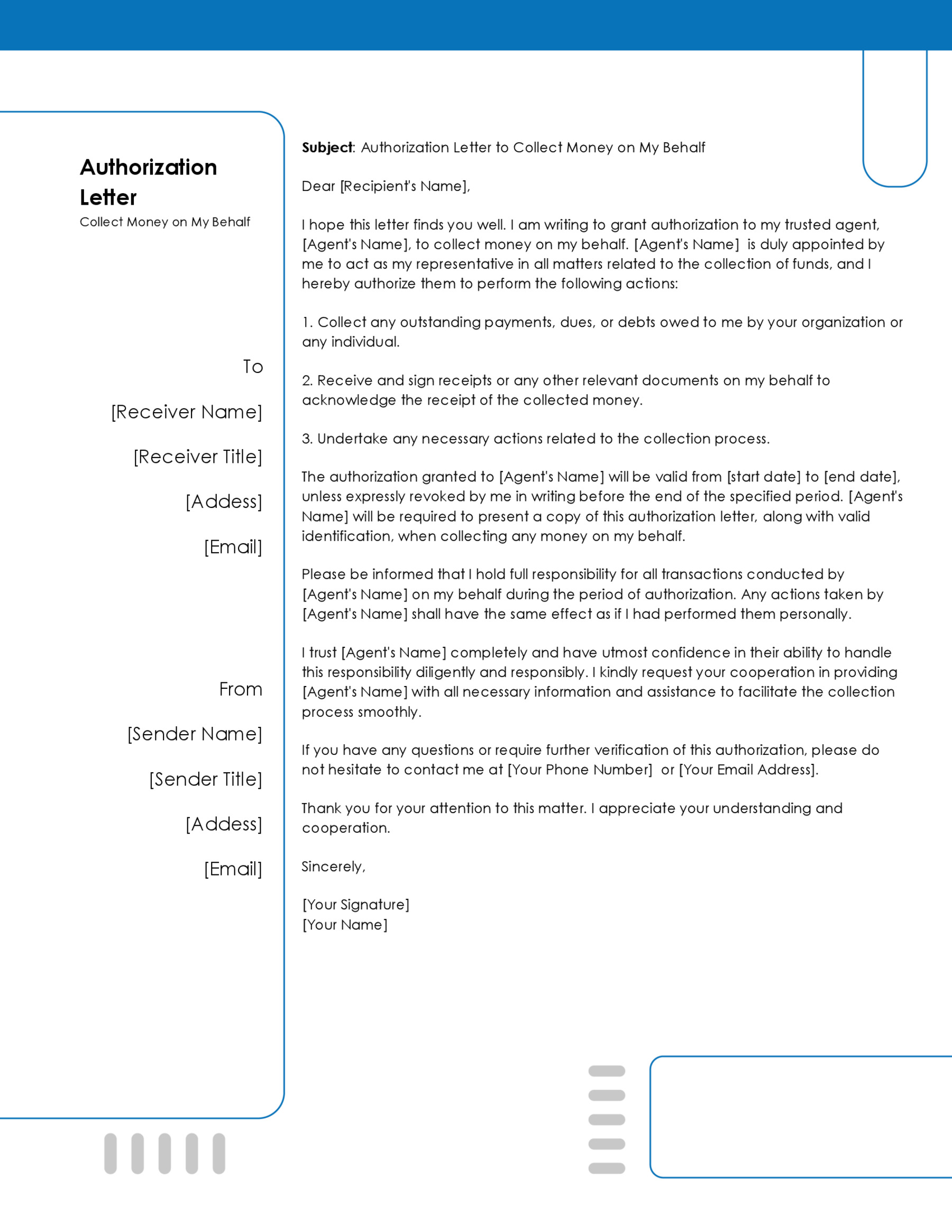Rent increments are practically inevitable for landlords due to the ever-changing dynamics of the real estate sector. Unfortunately, these changes to the rent cannot be implemented with due diligence.
A letter for rent increase is one way of ensuring landlords are compliant with the procedure for increasing rent. It is written to relay this information to the tenants and acts as a formal notification to the tenants.
Rent is ordinarily increased between 2-5% of the current rent. The letter is primarily used for month-to-month rental agreements, and it can only be used with standard (fixed) leases if the lease is near its expiration. If the proper procedures and regulations are followed, the landlord can increase rent without negotiation, and they ought to be aware that tenants can accept or reject the changes.
It is a formal letter used by landlords to communicate to tenants about an increment in their rent. It serves as a formal notification to renters of the increment and must be issued in accordance with the terms of the lease and applicable state/local tenant laws. However, it is typically sent between 30 to 60 days or an applicable state notice period before the existing lease ends.
It is alternatively referred to as:
- Rent Increase Notice
- Notice of Rent Increase Form
Sample Letters
Below is our collection of sample letters for an increase in rent. In this comprehensive resource, we provide you with a selection of professionally crafted letters that can assist you in effectively communicating a rent increase to your tenants. By utilizing these samples, you can benefit from their clarity, structure, and adherence to formal language, ensuring a professional and respectful tone throughout your communication.
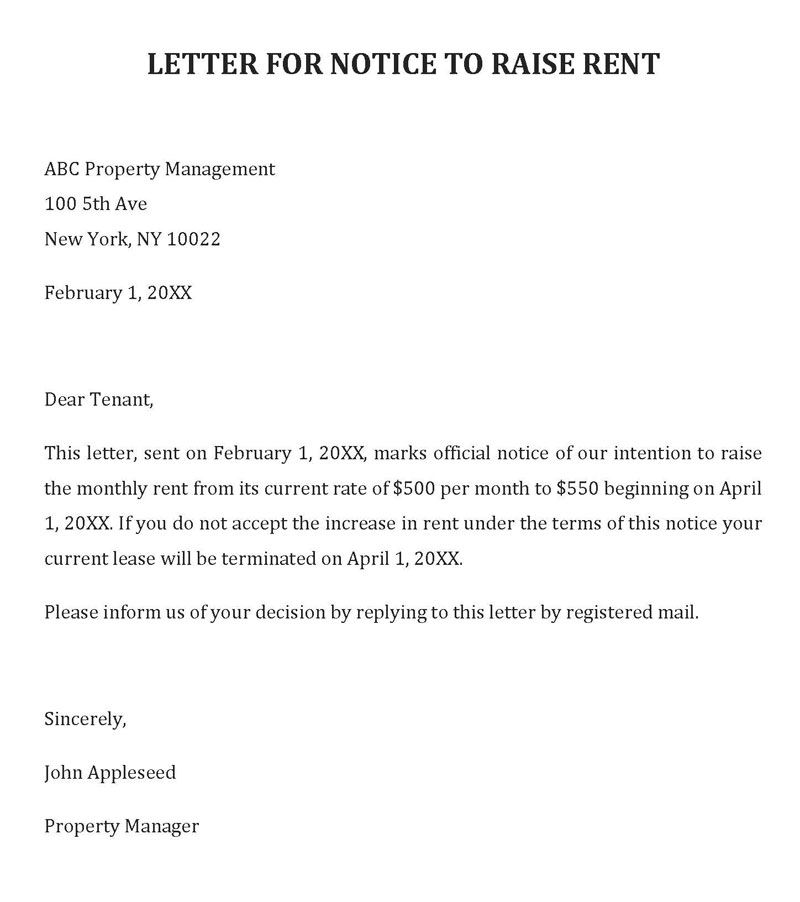
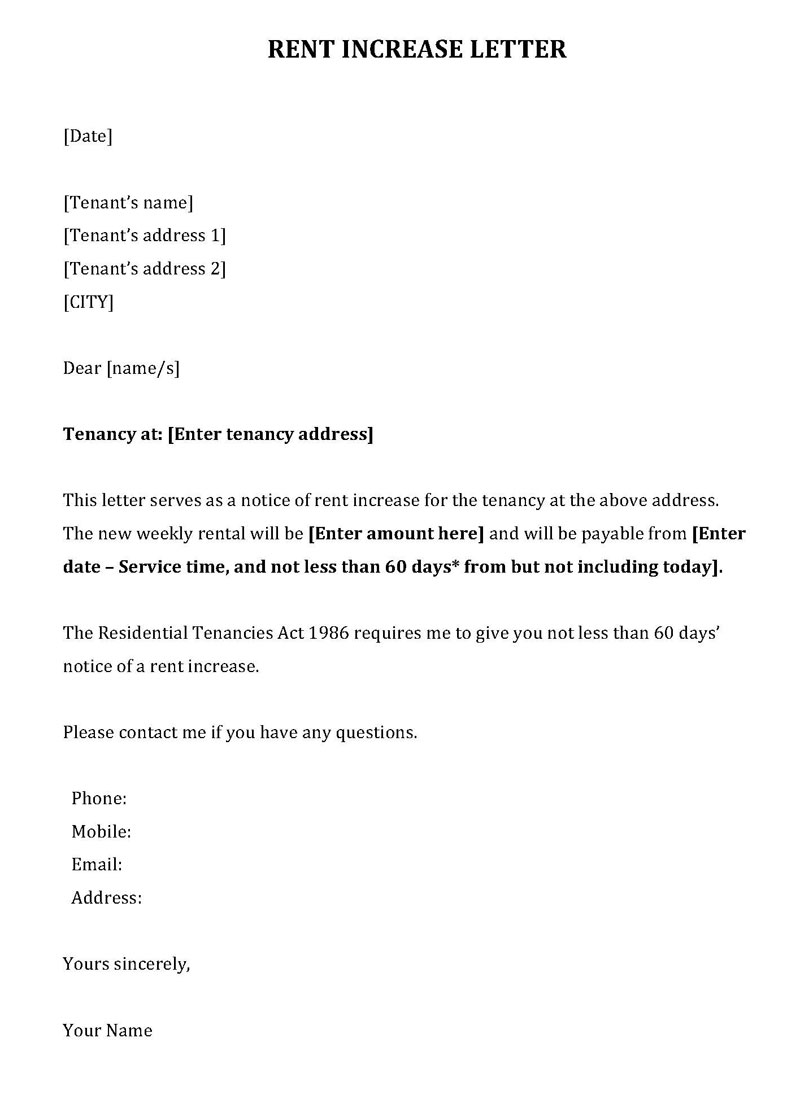
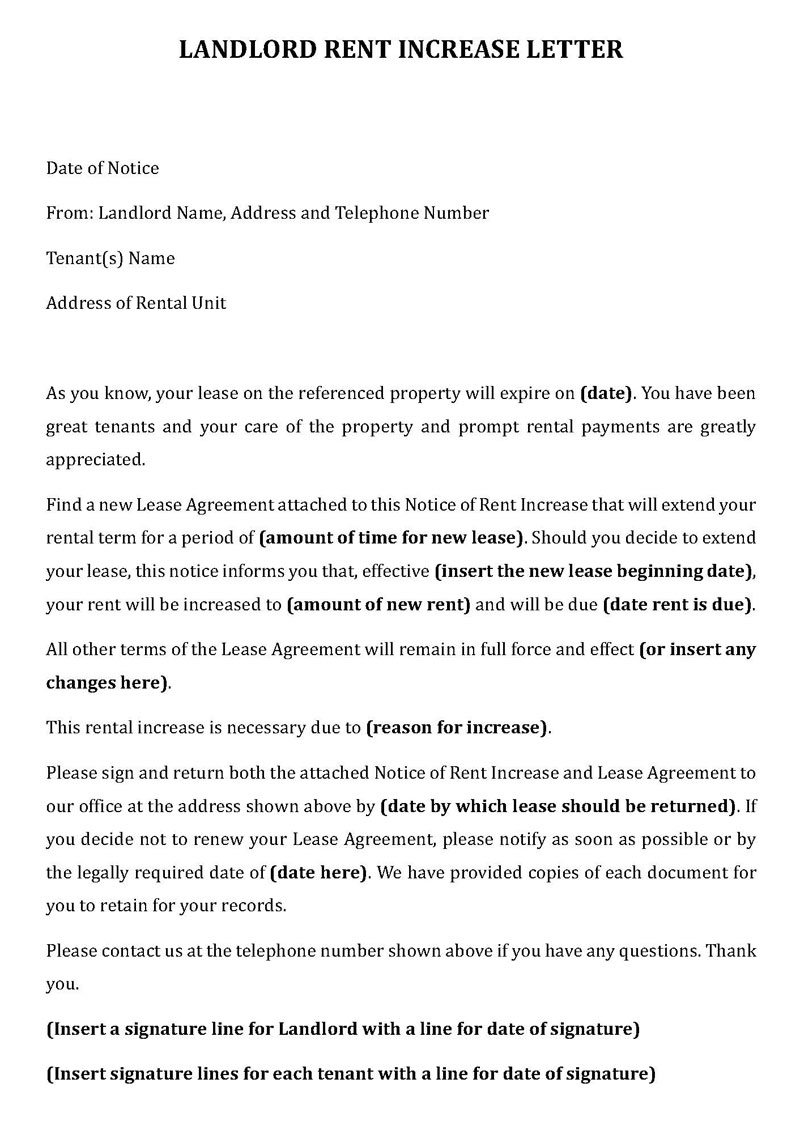
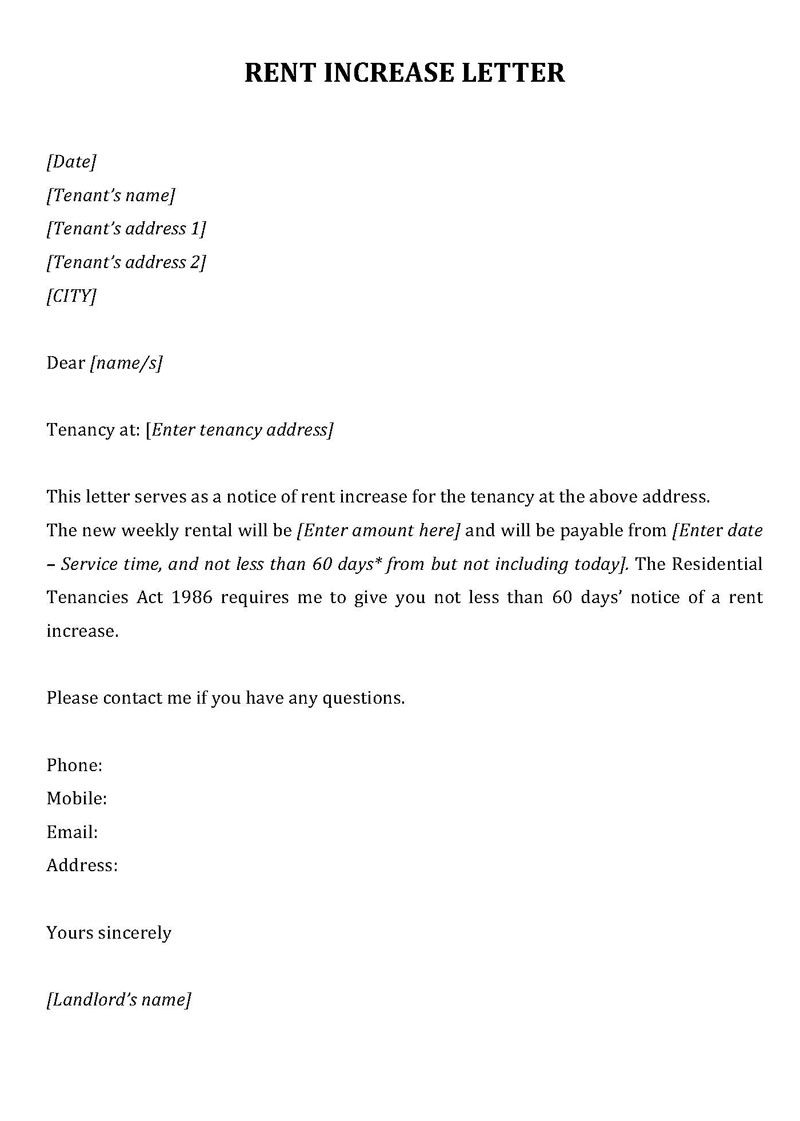
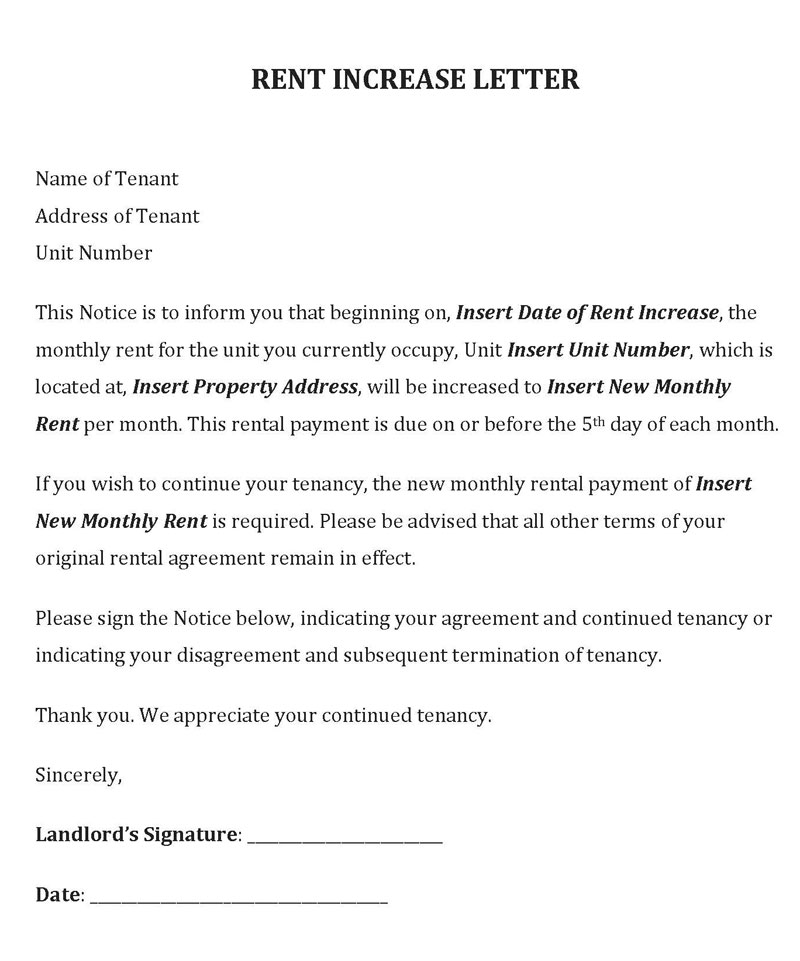
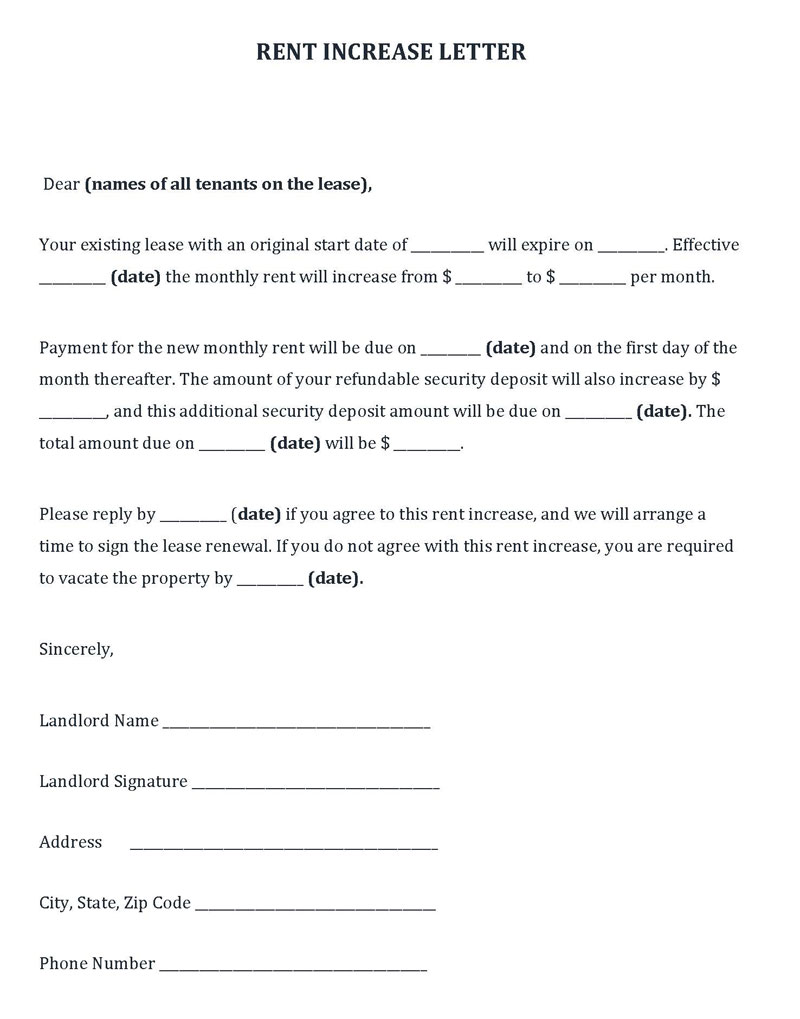
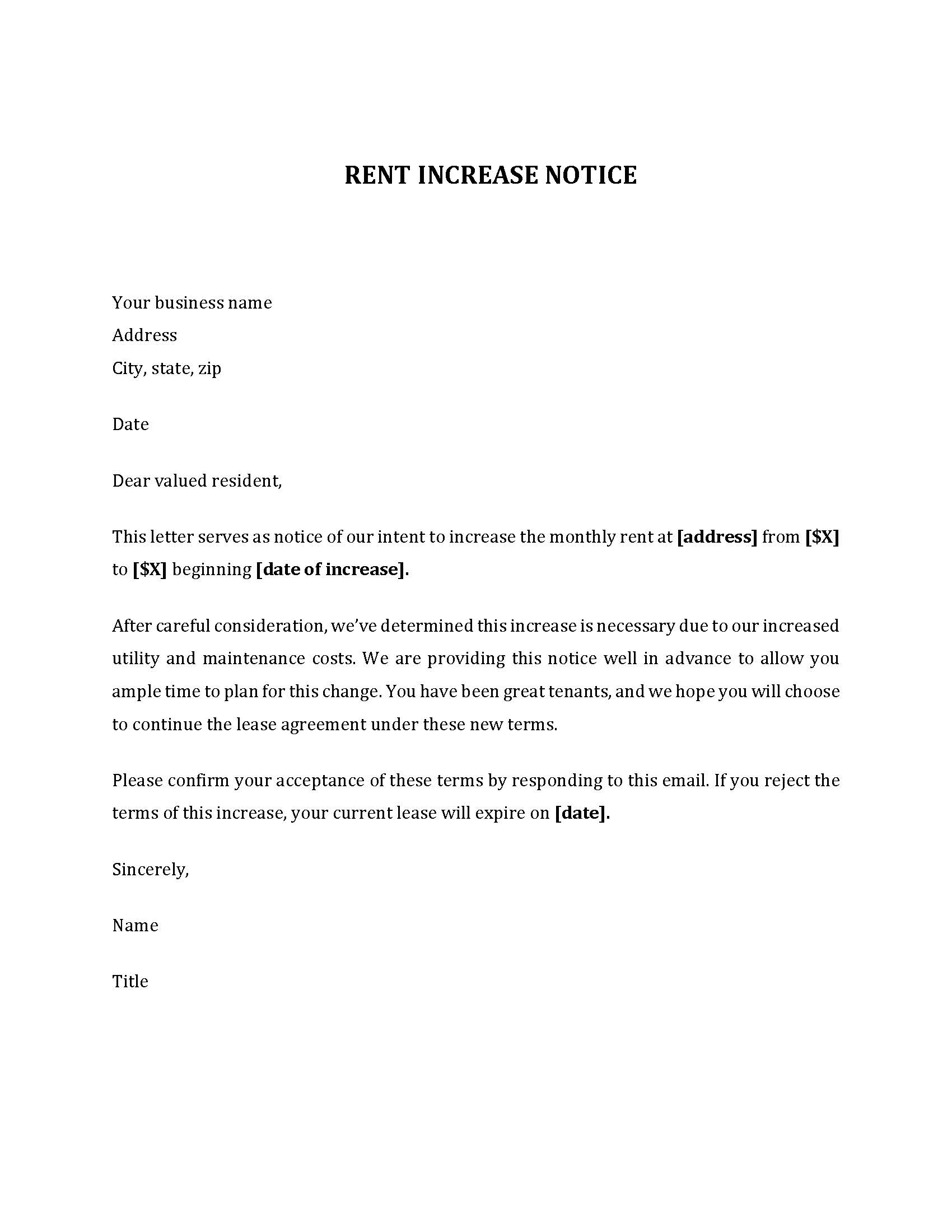
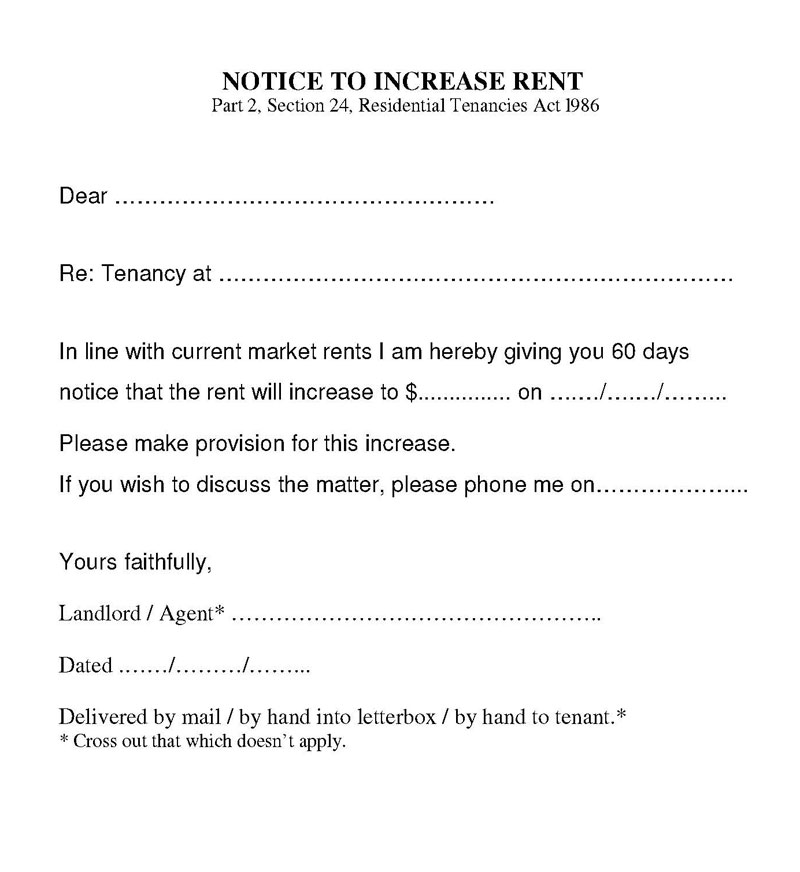
How to Legally Increase the Rent?
Landlords will commonly raise rent due to yearly rises in maintaining the property. Therefore, a rent increase may be a landlord’s solution to offset the rise in expenses.
A favorable rent increase can be conducted as follows:
Decide on the new rent
Before increasing rent, make sure that the increment will not drive your tenants away, and as a result, it is best to first compare your current and proposed rent with other similar properties in the area. An online search of rental rates in your area using reliable websites is a quick way of completing this step. Use the following criteria in your searches; Address the number of bedrooms and specialties such as houses with swimming pools, parking, etc.
Check your agreement
Next, consult the rental agreement signed by the tenant and determine whether it is a month-to-month lease or fixed lease, after which lookout for applicable terms and conditions of the rent increase. If the agreement allows you to implement rent increases, proceed with the process.
Check your state’s notice period
Being compliant with the law is strictly mandatory when increasing rent, otherwise a landlord may be exposing themselves to legal ramifications. Most states will have laws dictating the notice period landlords are expected to give their tenants when increasing rent. Also, look out for municipal and county laws. It is always advisable for landlords to issue enough notice, which often may be longer than the state requires. Ample notice is a good way of retaining your tenants and reputation as a landlord.
Consider factors that justify rent increases
Even though there are no regulations on how much to increase rent, it is always rational to justify the increase. Therefore, tenants will more than likely want to know the reason(s) for the increment. Some factors to consider are inflation, increased maintenance costs and utility bills, renovations and added amenities that increase the property’s market value, landlord insurance, HOA (homeowners association) dues, and increased property taxes (state or local).
Write and send the form
Once the rent increment has been established and all legal and contractual terms met, the landlord can craft this letter. Send it by the use of certified mail so that you can receive a return receipt which is kept as the official record that a notice was sent to the tenant and they received it. You can also send the tenant pamphlets of other similar properties to show why the rent increase is justified.
How to Write a Rent Increase Letter
It should communicate the landlord’s intention to increase the rent. While the specifics often differ from one circumstance to another, basic information ought to appear the same in a typical letter for rent increase to a tenant.
The following are steps to use when writing it:
Section 1: Header
The first section should be the header. Note that the letter must be formatted as a formal letter, so it must indicate the sender and the recipient. Therefore, the landlord’s name and contact details (address and phone number) should precede, followed by the date. After the date, indicate the tenant’s full name and property address.
Section 2: Greeting
After the tenant’s details, greet the tenant by referring to them by their names. Use a salutation like “Dear” followed by their full names. A subject line indicating the letter’s purpose can also be added.
Section 3: The concerned lease
The following section should refer to the initial lease agreement signed by the landlord and the tenant and a statement of when the increment is expected to start.
The following information should be given:
- Lease effective date: State the exact date as on the original lease agreement. This is essential in letting the tenant know that you reviewed the agreement and the increment complies with the applicable agreement.
- The date the rent increase will take effect: Next, indicate when the tenant should expect to start paying increased rent amounts if they choose to accept the new rent price.
Section 4: The proposed increase
Now that the tenant is aware of the matter, proceed to break down the details surrounding the rent increase. This will include indicating associated amounts and notice period.
For example, consider providing the following information:
- Current rental amount: Indicate the tenant’s current amount as rent. This figure can be obtained from the original agreement.
- Required dollar amount: State the revised rent amount and indicate it in figures and the appropriate monetary units.
- Payment due date: The next item should be the date after the increment when the tenant is expected to make their first payment: State the exact day, month, and year for clarity.
- Amount of notice period: After the payment due date, state the number of days the tenant has to accept or reject the increment – typically, the notice period is between a month or two before the first payment due date.
Section 5: Body of the letter
After informing the tenant of the rent changes you intend to implement, this letter will provide the support and additional information relevant to the rent increment and revision of the lease. It should be friendly and formal, considering a rent increase is not the good news any tenant would like to hear.
Consider discussing the following:
- Inform them that the rent increase notice is not a punishment: Make sure they understand that the rent increase is not a consequence of their actions but more of inevitability. Also, let them know they are still getting value for their money by outlining the exact reason for the increment. This helps in ensuring that tenants do not move out and may cause the landlord to lose more money than they would’ve without increasing rent.
- Request confirmation from the tenant: Always ask tenants to confirm their decision as soon as they make one. Indicate the most appropriate means to issue the confirmation; email, mail, or in-person.
- Offer means for the tenant to contact you: After being notified of the increment, it is more than likely that tenants will have specific queries they would like answered. Therefore, it is advisable to include a means of contact in the letter.
Section 6: Letter closing
The last segment is the letter’s closing. It should be formally concluded by providing a complimentary close followed by a signature and date of signing. It can be signed by the landlord, property manager, or someone with the appropriate authority.
When to Send a Rent Increase Letter
Knowing when to increase rent is essential in ensuring the landlord doesn’t get backlash from their tenants and making justifiable increments. Therefore, it is always imperative to monitor the market, compare current rates, and review apartment listings to determine the right time to increase rent. Other considerations are rent control and stabilization statutes that govern rent increase limits in some cities. Finally, a letter must be sent on time relative to the effective date of the rent increase.
Procedure to notify the tenant at the end of the lease
Ordinarily, for standard and fixed leases, the letter should be sent 30 to 60 days before the expiration date. However, the notice period can be more extended, up to 90 days, depending on the terms of the agreement, rent increase laws, and the amount of increment – high increments require more extended notice periods.
Procedure for a month-to-month lease
Such letters should be sent 30 days before the lease expiration date for month-to-month leases. A month-to-month lease will typically be more flexible and easier to increase rent since no long-term contractual obligations tie the landlord to the lease.
Rent Increase Letter Templates
TEMPLATE 01
[Landlord’s name]
[Address]
[Phone number]
[Date]
[Tenant’s name]
[Address]
Dear [tenant’s name]
Re: [subject of the letter]
This letter is sent as a formal notification that I will be raising rental rates from the current [current rent amount] to [new rent amount]. This increment will take effect of [effective date of rent increase], giving you 60 days’ notice in this regard. Kindly take heed of this increase.
This increment has resulted from the following;
· Reason 1 [reason(s) for increment such as the increased property taxes]
· Reason 2
· Reason 3
Payments shall be made with the already existing methods, and the effective due date remains per the rental agreement signed on[date]. Again, I thank you for your continuous support.
Yours faithfully,
[Signature]
TEMPLATE 02
TO:
__________
__________
__________
Purpose of Notice: This Notice is to inform the Tenant that _________(Landlord), will increase the rent. From the date _____ on, the monthly rent for ________________ (address) will be __________ (price) per month.
The current lease will be terminated on ________ (date of termination) as per the current agreement.
Landlord Signature: _________
Date: __________
TEMPLATE 03
TO:
___________
___________
___________RE: Notice of rent increase
Date: _________
Dear ________ (tenant):
I would like to take a minute to let you know exactly how much I value you as a tenant. It can be hard to find such model tenants. Unfortunately, I have experienced some unexpected expenses with the property and am forced to raise the rent accordingly.
You current lease will be officially terminated on _______ (date). The new rent will be _______(price) after that date. Should you wish to continue renting either on a monthly basis or by a longer agreement, this new rate is required.
Again, thank you for being such a wonderful tenant. I hope that you will continue to be a tenant at ______ (address). If you have any questions, please feel free to call me at ________(phone number).
Sincerely,
________ (Landlord’s signature)
________ (Landlord’s printed name)
Rent Increase Letter Sample
A sample letter is presented below for your guidance.
sAMPLE
Dear Mr. John Doe,
I hope this letter finds you well. I am writing to inform you of a forthcoming change to the terms of your rental agreement for the property located at 123 Maple Street, Springfield.
As you may be aware, the cost of maintaining and improving rental properties has been steadily rising. To continue providing you with high-quality living conditions and to keep up with these increasing expenses, it has become necessary to adjust the rent accordingly.
Effective January 1, 20XX, the monthly rent for your residence will be increased from $1,200 to $1,350. This adjustment is in line with market rates and reflects the value and quality of the housing we strive to provide.
Please note that this increase is being implemented following the terms of our lease agreement and local regulations. We value you as a tenant and are committed to making this transition as smooth as possible. If you have any questions or concerns regarding this change, please feel free to contact me.
Thank you for your understanding and continued tenancy. We look forward to providing you with a comfortable and well-maintained home.
Sincerely,
Ms. Emily Smith
Property Manager, ABC Realty
[email protected] | (555) 123-4567
Analysis
- Clarity and Simplicity: The language used in the letters is clear, avoiding legal jargon or overly complex terms. This makes the message easily understandable for a broad range of tenants, ensuring that the intent of the letter is communicated effectively.
- Professional Tone: Despite the simplicity, the tone remains professional and respectful. This is important in maintaining a positive landlord-tenant relationship, as it shows respect for the tenant while still clearly stating the landlord’s position and needs.
- Factual and Informative: The letters include all necessary information, such as the current and new rent amounts, the effective date of the increase, and the property address. This detail-oriented approach ensures that tenants are fully informed about the changes and there is no ambiguity.
- Reference to Market Conditions: By mentioning the rising costs of maintaining and improving rental properties, and aligning the increase with market rates, the landlord provides context and justification for the rent increase. This helps tenants understand that the increase is not arbitrary but is based on external economic factors.
- Legal and Contractual Awareness: The landlord acknowledges the terms of the lease agreement and local regulations, indicating that the rent increase is being done in accordance with legal requirements. This reassures the tenant that the process is legitimate and fair.
- Openness for Communication: The landlord has written a letter that fosters an open line of communication. This is crucial in handling any potential disputes or misunderstandings amicably.
- Appreciation for Tenancy: Expressing gratitude for the tenant’s continued occupancy and looking forward to providing a well-maintained home helps in maintaining a positive relationship. It recognizes the tenant’s value and can make the news of a rent increase more palatable.
These elements make the letters an excellent template for landlords seeking to communicate rent increases in a manner that is clear, professional, legally sound, and respectful of tenant relationships.
Essential Tips
Anytime you write it, it is best to make it as comprehensive and direct as possible.
Below are tips that landlords can utilize when writing it:
Be knowledgeable of market trends
To crop up a fair rent increase and create a letter that effectively communicates the landlord’s intent, check the current market trends within the locality. This includes rental rates of similar property, tenant preferences, local regulations, etc. Remember that you may be required to justify the increment,o it is only advisable to ensure you have the correct information.
Incorporate new payment methods
If the landlord has adopted new payment methods, they should declare it to tenants in the letter. If the original lease only listed checks and cash but you would like to transition to modern payment methods, state it and provide details for tenants to use.
Keep the documents signed
Always sign and attach it to the original lease as an appendix. These documents are crucial so there shouldn’t be any misunderstandings or legal battles in the future.
How to Deliver a Rent Increase Letter
Different methods can be used to deliver it to tenants. Some states have specific delivery requirements for sending notices, such as this letter. However, it is advisable to use methods that can be used in case the document has to be referenced later on. Such methods include certified mail with a return receipt, email (in states where permitted), and in-person. Certified mail and in-person deliveries are the most preferred methods.
Frequently Asked Questions
The amount of rent a landlord can increase depends on rent control statutes in the locality. There are typically two types of rent control statutes, vacancy control and vacancy decontrol. With vacancy decontrol statutes, landlords can increase the rent as they see fit once a lease agreement expires and a new one is signed into effect. However, it is always advisable to increase rent by a reasonable percentage to keep your tenants satisfied with your decision. On the other hand, vacancy control statutes have more stringent regulations that limit landlords from charging more than the stipulated base rent.
The extent of notice given to tenants is dependent on the type of lease and the amount of rent increment. Typically, a notice ranging from 30 to 60 days will be sufficient for most leases. Other state statutes may apply, and landlords can consult an attorney to comply.
Generally, landlords are allowed to increase rent annually if deemed necessary. However, it is always recommended that landlords review applicable state, municipal, or county rent control regulations before increasing rent.











